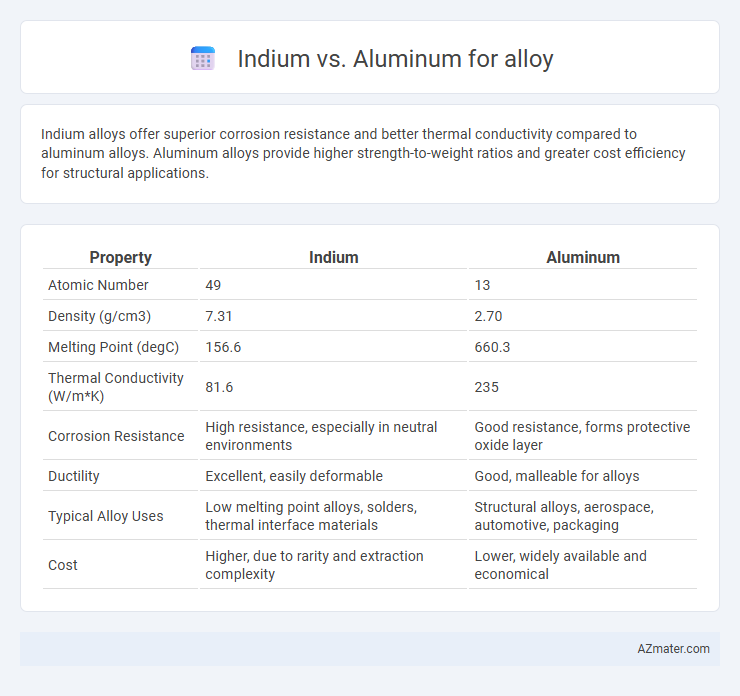Indium alloys offer superior corrosion resistance and better thermal conductivity compared to aluminum alloys. Aluminum alloys provide higher strength-to-weight ratios and greater cost efficiency for structural applications.
Table of Comparison
| Property | Indium | Aluminum |
|---|---|---|
| Atomic Number | 49 | 13 |
| Density (g/cm3) | 7.31 | 2.70 |
| Melting Point (degC) | 156.6 | 660.3 |
| Thermal Conductivity (W/m*K) | 81.6 | 235 |
| Corrosion Resistance | High resistance, especially in neutral environments | Good resistance, forms protective oxide layer |
| Ductility | Excellent, easily deformable | Good, malleable for alloys |
| Typical Alloy Uses | Low melting point alloys, solders, thermal interface materials | Structural alloys, aerospace, automotive, packaging |
| Cost | Higher, due to rarity and extraction complexity | Lower, widely available and economical |
Introduction to Indium and Aluminum Alloys
Indium alloys, known for their low melting points and excellent thermal and electrical conductivity, are primarily used in electronics, solders, and specialized coatings. Aluminum alloys, characterized by their lightweight, high strength-to-weight ratio, and corrosion resistance, dominate aerospace, automotive, and construction industries. The distinct metallurgical properties of indium and aluminum alloys influence their applications, with indium enhancing flexibility and conductivity, while aluminum provides structural strength and durability.
Chemical and Physical Properties Comparison
Indium exhibits a melting point of 156.6degC and a density of 7.31 g/cm3, while aluminum melts at a significantly higher temperature of 660.3degC with a density of 2.70 g/cm3, making aluminum alloys lighter for structural applications. Chemically, indium is more malleable and resistant to oxidation, promoting enhanced corrosion resistance in alloys, whereas aluminum forms a stable oxide layer that protects against environmental degradation. The distinct electrical conductivity of aluminum, approximately 37.7 million S/m, surpasses that of indium, which limits indium's use in conductive alloy systems but benefits applications requiring thermal or mechanical flexibility.
Alloy Formation: Indium vs Aluminum
Indium and aluminum differ significantly in their alloy formation properties due to their atomic structures and melting points. Indium forms alloys primarily with metals like lead, tin, and silver, exhibiting low melting points and excellent ductility, which is advantageous for soldering applications. Aluminum alloys, meanwhile, are widely used in structural materials because of their strength, corrosion resistance, and lightweight nature, often combined with elements like copper, magnesium, and zinc to enhance mechanical properties.
Mechanical Strength and Durability
Indium alloys typically exhibit lower mechanical strength compared to aluminum alloys, making aluminum preferable for applications requiring high structural integrity. Aluminum alloys demonstrate superior hardness, tensile strength, and resistance to wear, contributing to enhanced durability in demanding environments. The corrosion resistance of aluminum alloys further supports their longevity, whereas indium's softness limits its use to specialized applications such as soldering or coatings.
Corrosion Resistance and Environmental Stability
Indium alloys exhibit superior corrosion resistance compared to aluminum alloys, especially in acidic and marine environments where indium forms a stable, protective oxide layer that inhibits degradation. Aluminum alloys, while lightweight and cost-effective, are more prone to pitting and galvanic corrosion without appropriate surface treatments or coatings. Indium's enhanced environmental stability under fluctuating temperature and humidity conditions makes it a preferred choice in specialized corrosion-resistant applications.
Electrical and Thermal Conductivity
Indium exhibits superior electrical conductivity compared to aluminum, making it ideal for applications requiring low resistance and efficient current flow. Its thermal conductivity is also notably higher, enhancing heat dissipation in electronic components and thermal interface materials. While aluminum is lightweight and cost-effective, indium's unique conductive properties offer distinct advantages in high-performance alloy applications.
Industrial Applications and Use Cases
Indium alloys are prized in electronics and aerospace for their excellent conductivity and corrosion resistance, enabling reliable performance in thermal interface materials and soldering applications. Aluminum alloys dominate automotive and construction industries due to their lightweight strength, high tensile properties, and cost-effectiveness. While indium enhances specialized components with superior conductivity and malleability, aluminum offers versatile scalability for mass production in structural and thermal applications.
Cost-Effectiveness and Material Availability
Indium alloys typically offer enhanced corrosion resistance and superior thermal conductivity compared to aluminum alloys but come at a significantly higher cost due to limited global reserves and more complex extraction processes. Aluminum alloys are favored for cost-effectiveness and widespread availability, benefiting from established supply chains and abundant global deposits, making them ideal for large-scale manufacturing applications. For cost-sensitive projects requiring bulk materials, aluminum alloys provide a more economically viable option, whereas indium alloys are reserved for specialized uses where performance margins justify the premium price.
Environmental Impact and Recyclability
Indium alloying offers unique electrical and thermal properties but is limited by scarce global reserves, raising sustainability concerns, whereas aluminum is abundant, highly recyclable, and less environmentally taxing due to well-established recycling infrastructure that reduces energy consumption by up to 95%. Aluminum alloys benefit from a circular economy model with mature recovery methods that minimize landfill waste and decrease greenhouse gas emissions significantly. The environmental footprint of indium alloys remains higher due to energy-intensive extraction processes and limited recycling rates compared to the extensive aluminum recycling networks.
Conclusion: Choosing the Right Alloy for Your Needs
Indium alloys offer superior corrosion resistance and excellent thermal and electrical conductivity, making them ideal for specialized applications in electronics and aerospace. Aluminum alloys provide a balanced combination of lightweight strength, cost-effectiveness, and ease of fabrication, widely used in automotive and construction industries. Selecting the right alloy depends on performance requirements, environmental conditions, and budget constraints specific to the project.

Infographic: Indium vs Aluminum for Alloy
 azmater.com
azmater.com